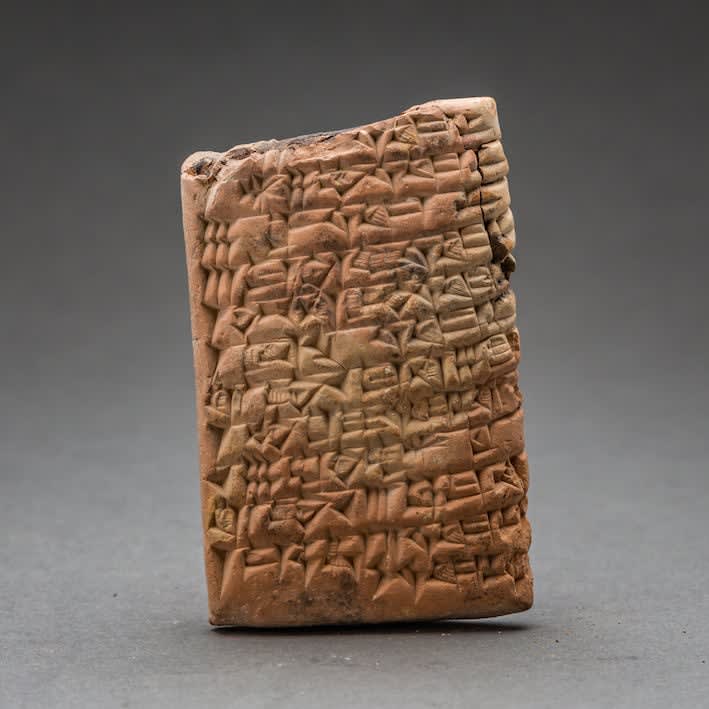Sumerian Cuneiform Tablet, 2030 BCE
Terracotta
2 x 3.5
LSO.101
Sumerian cuneiform is one of the earliest known forms of written expression. First appearing in the 4th millennium BC in what is now Iraq, it was dubbed cuneiform (‘wedge-shaped’) because...
Sumerian cuneiform is one of the earliest known forms of written expression. First appearing in the 4th millennium BC in what is now Iraq, it was dubbed cuneiform (‘wedge-shaped’) because of the distinctive wedge form of the letters, created by pressing a reed stylus into wet clay. Early Sumerian writings were essentially pictograms, which became simplified in the early and mid 3rd millennium BC to a series of strokes, along with a commensurate reduction in the number of discrete signs used (from c.1500 to 600). The script system had a very long life, and was used by the Sumerians as well as numerous later groups – notably the Assyrians, Elamites, Akkadians and Hittites – for around three thousand years. Certain signs and phonetic standards live on in modern languages of the Middle and Far East, but the writing system is essentially extinct. It was therefore cause for great excitement when the ‘code’ of ancient cuneiform was cracked by a group of English, French and German Assyriologists and philologists in the mid 19th century AD. This opened up a vital source of information about these ancient groups that could not have been obtained in any other way. Cuneiform was used on monuments dedicated to heroic – and usually royal – individuals, but perhaps it’s most important function was that of record keeping. The palace-based society at Ur and other large urban centres was accompanied by a remarkably complex and multifaceted bureaucracy, which was run by professional administrators and a priestly class, all of whom were answerable to central court control. Most of what we know about the way the culture was run and administered comes from cuneiform tablets, which record the everyday running of the temple and palace complexes in minute detail, as in the present case. The Barakat Gallery has secured the services of Professor Lambert (University of Birmingham), a renowned expert in decipherment and translation of cuneiform, to examine and process the information on these tablets. His analysis is presented below. This tablet has a total of 25 lines on obverse and reverse, and is written in a large, clear scribal hand. The top of the obverse and the bottom of the reverse are damaged but the rest of the text is preserved and clear. It is a document dated to the 6th year of Shi-Sin, c. 2030 BC. It is a list of bronze vessels under the care of a priest called the Lumah. Presumably this was the whole stock of such vessels in his place of worship. Other tablets of this period are known with such lists of vessels, but this one has many rare words and even one sign not yet understood.
Translation: [……..] of bronz 1 bronze goble 6 bronze cauldron 3 bronze mirror 1 bronze cu 1 bronze dish (?): their weight: 10 minas, 5 shekel 1 bronze barber’s razor, weight not note 16 bronze travelling……their weight 15 and 5/6 mina 1 bronze balance for weighing silver, set with a bronze…
1 bronze balance for weighing silver, set with a lead…
31 minas 5 shekels of bronz
Property of the Lumah priest: Basmum, the scribe, received the bronze………
Year: Shu-Sin, king of Ur, erected a magnificent stele for Enlil and Ninli The word for ‘cup’ is in fact Elamite, from the kingdom in southwest Iran. We only have what is written, but it may be conjectured that the scribe was in fact checking the stock of bronze vessels for the king or some high state official.
Translation: [……..] of bronz 1 bronze goble 6 bronze cauldron 3 bronze mirror 1 bronze cu 1 bronze dish (?): their weight: 10 minas, 5 shekel 1 bronze barber’s razor, weight not note 16 bronze travelling……their weight 15 and 5/6 mina 1 bronze balance for weighing silver, set with a bronze…
1 bronze balance for weighing silver, set with a lead…
31 minas 5 shekels of bronz
Property of the Lumah priest: Basmum, the scribe, received the bronze………
Year: Shu-Sin, king of Ur, erected a magnificent stele for Enlil and Ninli The word for ‘cup’ is in fact Elamite, from the kingdom in southwest Iran. We only have what is written, but it may be conjectured that the scribe was in fact checking the stock of bronze vessels for the king or some high state official.



